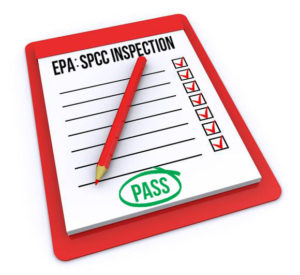Know the 3 Things Inspectors Look For in A Spill Plan
When someone thinks of spill prevention, they usually think about crude oil or gasoline spills. However, spill compliance incorporates a little catchall that most companies slip up on: “oil-like” substances. Oil like includes products beyond petroleum based oils. It includes chemicals that may behave like oil in navigable waters, like animal fats, grease, vegetable oil, olive oil, mineral oils or lube oils.
The Code of Federal Regulations provides the following definitions for types of oil covered in oil pollution prevention. As a reminder, the storage thresholds for these oils are 1,320 gallons or more stored aboveground and 42,000 gallons stored underground.
- Non-petroleum oil means oil of any kind that is not petroleum-based, including but not limited to: Fats, oils, and greases of animal, fish, or marine mammal origin; and vegetable oils, including oils from seeds, nuts, fruits, and kernels.
- Oil means oil of any kind or in any form, including, but not limited to: fats, oils, or greases of animal, fish, or marine mammal origin; vegetable oils, including oils from seeds, nuts, fruits, or kernels; and, other oils and greases, including petroleum, fuel oil, sludge, synthetic oils, mineral oils, oil refuse, or oil mixed with wastes other than dredged spoil.
- Petroleum oil means petroleum in any form, including but not limited to crude oil, fuel oil, mineral oil, sludge, oil refuse, and refined products.
Read More About Who Is Responsible for SPCC Compliance, Businesses or Suppliers
Make sure that workers and supervisors understand that spills include ALL TYPES of oil substances and chemicals. Training and Spill Prevention Control and Countermeasures (SPCC) should be updated to reflect knowledge of substances covered under Oil Pollution Prevention.
 So what do inspectors look for?
So what do inspectors look for?
- Does your cross-reference sheet match the SPCC Amendments rule enacted in 2009? The cross-reference sheet is a required part of the document. This outlines where in your SPCC each regulation is addressed. Be mindful that SPCC regulations were updated in 2009.
- Does your facility diagram include accurate placements of tanks? The diagram should reflect only what is on site, as well as what the transfer area looks like.
- Are your employees trained? All training records must contain who completed SPCC training, when the training occurred and any testing documents. Employees also must sign the training roster sheet.
Learn How One Company Got Fined For Not Having a Spill Plan
Still have questions? Our SRP Environmental Consultants have extensive experience in producing and reviewing Spill Prevention Control and Countermeasures plans for companies of all sizes in different industries. We have seven convenient locations in Charlotte, Dallas, Denver, Honolulu, Midland, Shreveport and Pittsburgh. Contact SRP today at (318) 222-2364.

 ">
">
 ">
">